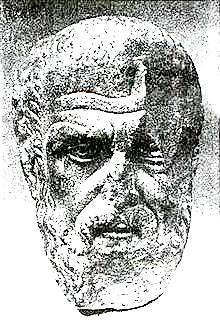Nicomedia
 Shown within Turkey | |
| Location | Turkey |
|---|---|
| Region | Kocaeli Province |
| Coordinates | Coordinates: 40°46′N 29°55′E / 40.767°N 29.917°E |
Nicomedia (/ˌnɪkəˈmiːdiə/;[1] Greek: Νικομήδεια, Nikomedeia; modern İzmit) was an ancient Greek city in what is now Turkey.
History
It was founded in 712/11 BC as a Megarian colony and was originally known as Astacus (/ˈæstəkəs/; Ancient Greek: Ἀστακός, "lobster").[2] After being destroyed by Lysimachus,[3] it was rebuilt by Nicomedes I of Bithynia in 264 BC under the name of Nicomedia, and has ever since been one of the most important cities in northwestern Asia Minor. The great military commander Hannibal Barca came to Nicomedia in his final years and committed suicide in nearby Libyssa (Diliskelesi, Gebze). The historian Arrian was born there.

Nicomedia was the metropolis of Bithynia under the Roman Empire, and Diocletian made it the eastern capital city of the Roman Empire in 286 when he introduced the Tetrarchy system. Nicomedia remained as the eastern (and most senior) capital of the Roman Empire until co-emperor Licinius was defeated by Constantine the Great at the Battle of Chrysopolis (Üsküdar) in 324. Constantine mainly resided in Nicomedia as his interim capital city for the next six years, until in 330 he declared the nearby Byzantium (which was renamed Constantinople) the new capital. Constantine died in a royal villa in the vicinity of Nicomedia in 337. Owing to its position at the convergence of the Asiatic roads leading to the new capital, Nicomedia retained its importance even after the foundation of Constantinople.[5]
A major earthquake, however, on 24 August 358, caused extensive devastation to Nicomedia, and was followed by a fire which completed the catastrophe. Nicomedia was rebuilt, but on a smaller scale.[6] In the sixth century under Emperor Justinian I the city was extended with new public buildings. Situated on the roads leading to the capital, the city remained a major military center, playing an important role in the Byzantine campaigns against the Caliphate.[7]
In 451, the local bishopric was promoted to a Metropolitan see under the jurisdiction of the Ecumenical Patriarchate of Constantinople.[8] The metropolis of Nicomedia was ranked 7th in the Notitiae Episcopatuum among the metropolises of the patriarchate.[9] In the eighth century the Emperor Constantine V established his court there for a time, when plague broke out in Constantinople and drove him from his capital in 746-47.[10] From the 840s on, Nicomedia was the capital of the thema of the Optimatoi. By that time, most of the old, seawards city had been abandoned and is described by the Persian geographer Ibn Khurdadhbih as lying in ruins. The settlement had obviously been restricted to the hilltop citadel.[7] In the 1080s, the city served as the main military base for Alexios I Komnenos in his campaigns against the Seljuk Turks, and the First and Second Crusades both encamped there.
The city was briefly held by the Latin Empire following the fall of Constantinople to the Fourth Crusade in 1204: in late 1206 the seneschal Dietrich von Los made it his base, converting the church of Saint Sophia into a fortress; however the Crusader stronghold was subjected to constant raids by the Emperor of Nicaea Theodore I Laskaris, during which von Los was captured by Nicaean soldiers; by the summer of 1207 Emperor Henry of Flanders agreed to evacuate Nicomedia in exchange for von Los and other prisoners Emperor Theodore held.[11] The city remained in Byzantine control for over a century after that, but following the Byzantine defeat at the Battle of Bapheus in 1302, it was threatened by the rising Ottoman beylik. The city was twice blockaded by the Ottomans (in 1304 and 1330) before finally succumbing in 1337.[7]
Notable natives and residents
- Diocletian
- Arrian (Lucius Flavius Arrianus 'Xenophon')
- Saint George
- Saint Barbara
- Saint Panteleimon
- Adrian of Nicomedia
- Anthimus of Nicomedia
- Arsacius of Nicomedia
- Cecropius of Nicomedia
- Juliana of Nicomedia
- Theopemptus of Nicomedia
- Theophylact of Nicomedia
- Michael Psellos (11th century) Greek writer, philosopher, politician, and historian
- Maximus Planudes (13th century) Greek scholar, anthologist, translator and grammarian
- Aaron ben Elijah Karaite Jewish Philosopher and Commentator. Author of Keter Torah, Gan Eden, and 'Etz Hayyim
-
_by_shakko.jpg)
St. Pantaleon
-

Arrian
-
_-_Foto_G._Dall'Orto_28-5-2006.jpg)
Diocletian
-
.jpg)
Licinus
See also
- 20,000 Martyrs of Nicomedia
- Nicaea (present-day İznik, another important city in Bithynia, and the interim Byzantine capital city between 1204 and 1261 (Empire of Nicaea) following the Fourth Crusade in 1204, until the recapture of Constantinople by the Byzantines in 1261. Earlier, the site of the Nicene Creed as well as the First Council of Nicaea and Second Council of Nicaea.)
References
- ↑ "Nicomedia" in the American Heritage Dictionary
- ↑ Peter Levi (ed.). Guide to Greece By Pausanias. p. 232. ISBN 0-14-044225-1.
- ↑ Cohen, Getzel M. The Hellenistic settlements in Europe, the islands, and Asia Minor. p. 400. ISBN 0-520-08329-6.
- ↑ "Belt Section with Medallions of Constantius II and Faustina". The Walters Art Museum.
- ↑ See C. Texier, Asie mineure (Paris, 1839); V. Cuenet, Turquie d'Asie (Paris, 1894).
- ↑ See Ammianus Marcellinus 17.7.1–8
- 1 2 3 Kazhdan, Alexander, ed. (1991), Oxford Dictionary of Byzantium, Oxford University Press, pp. 1483–1484, ISBN 978-0-19-504652-6
- ↑ Kiminas, Demetrius (2009). The Ecumenical Patriarchate. Wildside Press LLC. p. 79. ISBN 9781434458766.
- ↑ Terezakis, Yorgos. "Diocese of Nicomedia (Ottoman Period)". Εγκυκλοπαίδεια Μείζονος Ελληνισμού, Μ. Ασία. Retrieved 13 November 2012.
- ↑ David Turner, The Politics of Despair: The Plague of 746-747 and Iconoclasm in the Byzantine Empire, The Annual of the British School at Athens, Vol. 85 (1990), p428
- ↑ Geoffrey de Villehardouin, translated by M. R. B. Shaw, Joinville and Villehardouin: Chronicles of the Crusades (London: Penguin, 1963), pp. 147, 154–56
Coordinates: 40°46′N 29°55′E / 40.767°N 29.917°E